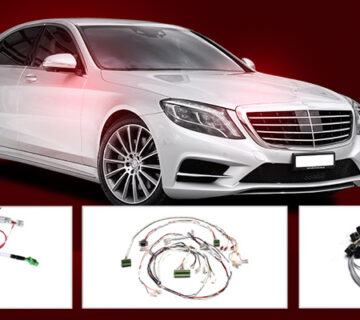Wire harnesses are the lifelines of the complex ecology of automotive engineering, providing smooth communication and operation in vehicles. Engineers, however, face a maze of difficulties in the design and production of these harnesses as they work to uphold exacting standards of efficiency, safety, and quality. Let’s reveal the typical roadblocks that arise during the design and production of automobile wire harnesses that engineers must overcome to achieve perfection. Automotive experts may overcome these obstacles to build harnesses that outperform expectations in terms of performance and longevity by embracing cutting-edge techniques, using modern materials, and encouraging cross-disciplinary cooperation. Come along as we explore the intricacies of wire harness design and reveal how engineering prowess is achieved in the automobile industry.
Understanding the complexities of wire harness design
Wire harnesses are complicated assemblies that weave together a variety of wires, connections, terminals, and protective components in the complex web of automobile engineering. The main challenge in their design is skillfully negotiating this complexity. Careful design is required to minimize interference, maximize space utilization, and make maintenance and repairs easier to access. Modern cars also have a plethora of electrical equipment, many of which require customized wire layouts. A careful balancing act between experience and vision is required to maintain manufacturability and cost-effectiveness while achieving harmony among these diverse needs. Every move in this high-stakes game of chess must be carefully considered in order to guarantee flawless operation and integration. Automotive experts try to precisely choreograph the symphony of wire harness design with finesse in this complex dance of technology and innovation.
Managing cost and weight constraints
Two persistent objectives in the automobile industry are weight reduction and cost optimization. Wire harnesses can present challenges here. The integration of more technological features and safety systems into automobiles necessitates more wire, leading to the development of larger and more expensive harnesses. Engineers are exploring novel materials and manufacturing techniques to address this issue. Aluminium and high-strength alloys are examples of lightweight materials that have the potential to reduce harness weight without sacrificing strength. Furthermore, there is potential for cost savings through streamlined production, reduced material waste, and the use of modular designs and standardized components. Each choice made in this delicate balancing act between efficiency and usefulness may improve vehicle performance and maximize value for both manufacturers and customers.
Mitigating manufacturing complexity and lead times
Automotive wire harness production involves a number of complex processes, such as wire cutting, stripping, crimping, and assembly. It is an enormous challenge to balance this complexity with large production volumes and shorter lead times. In order to optimize their processes, manufacturers resort to robots and automation. Efficiency, precision, and consistency are increased through automated wire cutting and stripping machines, crimping robots, and harness assembly systems. To further cut lead times and improve overall agility, adopting lean manufacturing concepts and streamlining supply chain logistics are essential tactics. Manufacturers may negotiate the difficulties of wire harness manufacturing with precision and elegance by utilizing efficiency-driven and automated wire harness processes. This ensures timely delivery of high-quality harnesses to satisfy the constantly changing demands of the automotive industry.
Ensuring compatibility and integration
and smooth integration across developing vehicle technology. Harness designs need to be updated often due to the quick development of new electrical modules, sensors, and communication protocols. Advanced simulation techniques and virtual prototyping are used to anticipate compatibility problems, allowing for early conflict detection and prompt modification. Furthermore, it is critical to promote cooperation between automotive OEMs and suppliers. Cross-functional teams coordinate their efforts to address interface issues, align design criteria, and improve the overall dependability and performance of the system. Effective integration of wire harnesses with vehicle subsystems is crucial in this dynamic environment where innovation propels advancement, guaranteeing that the beating heart of automotive connection keeps perfect time with the ever-advancing pulse of technology.
Ensuring quality and reliability
In the automobile sector, wire harness quality is a non-negotiable due to the importance of safety and dependability. Nevertheless, maintaining a high level of quality during extensive production runs is not without difficulties, especially when it comes to finding errors and making sure that strict performance guidelines are followed. Manufacturers use modern inspection technologies, such as X-ray inspection equipment and automated optical inspection systems, to meet quality assurance concerns. With the use of these tools, harnesses may be thoroughly inspected for flaws like miswires, improper crimping, and insulation damage, guaranteeing that they adhere to industry standards and client specifications. Furthermore, manufacturers may develop strict quality control procedures throughout every phase of manufacturing lifecycle by putting in place strong quality management systems and following international standards. By taking these steps, manufacturers maintain their promise to provide dependable, safe vehicles that meet the highest quality standards and exceed customer expectations.
Multidisciplinary teams must work together, be creative, and pay close attention to detailing while developing and manufacturing automobile wire harnesses. Automotive engineers and manufacturers can overcome obstacles and provide high-performance, dependable wire harness solutions that are in line with the changing needs of the automotive industry by taking on common challenges like complexity, cost, compatibility, manufacturing efficiency, and quality assurance head-on. Miracle Electronics, a prominent participant in the industry, specializes in the manufacture of automotive wire harnesses and brings knowledge, accuracy, and dependability to each project. In the dynamic world of automotive engineering, Miracle Electronics is a reliable partner for auto wire harness manufacturing in India, enabling cars with seamless connection and optimal performance with a focus on quality, innovation, and customer satisfaction.




